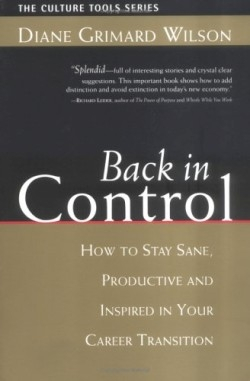Back in Control
How to Stay Sane Productive and Inspired in Your Career Transition
A career today is less likely to be a decades-long, one-company relationship than it was forty years ago. Now, a worker may change employers several times, or make a radical career shift. This volume, instead of the more usual resume-preparation, Internet research, and interview scripting of many career-change books, focuses on managing oneself and learning from previous experiences.
The author is a licensed clinical professional counselor with a master’s degree in clinical and counseling psychology. As a coach, she assists job-changing clients during the transition period (which often overlaps the end of the previous position), the job search, and the inaugural period of the new employment relationship. Wilson notes, “Whether the change is voluntary (‘I quit!’) or imposed from the outside (‘You’re fired!’), most people feel lost and alone at some point.”
The book offers real-life quotations from Wilson’s clients, some of whom have been retired, some let go as the result of downsizing, and others who are still employed but are exploring a new job or a change in their work situation. “For many of us, self-management in transition is no small task,” states the author. “For most, it is the most important.”
Wilson has contributed columns for Chicago Tribune’s Working Section feature “Insider,” and her work has appeared in Reader’s Digest, Conscious Choice, and trade publications. She is the founder of Grimard Wilson Consulting, Inc., which has focused for more than eighteen years on issues related to human side of work.
Each chapter of her book addresses a topic such as understanding what is really happening; being aware of one’s own situation; and recognizing key challenges and personal barriers, which can include lack of self-confidence, depression, and over-aggressive interview techniques. The author counsels consciousness of what has actually happened, and getting past any negative or traumatic history. She advocates using personal journals, and concludes each chapter with reflection exercises that call for written responses from the reader.
Chapter Five, for example, deals with conditioning the mind for success, and provides useful strategies for overcoming negative mind-sets with techniques like identifying negative paradigms and countering them with positive statements. One client substituted repeating “I am full of energy” instead of “I’m so tired,” and over time, moved from being sick and unhappy to planning his next career move. Chapter Eight deals with creating structure to stay focused, and includes some Feng Shui tips, such as removing clutter and distractions from one’s sleeping space.
An index would have made this book even more useful, but the author’s internal cross-referencing to other chapters makes up for that loss. In all, the book is a useful guide to anyone experiencing the angst of difficult workplace changes.
Reviewed by
Leonard F. Charla
Disclosure: This article is not an endorsement, but a review. The publisher of this book provided free copies of the book to have their book reviewed by a professional reviewer. No fee was paid by the publisher for this review. Foreword Reviews only recommends books that we love. Foreword Magazine, Inc. is disclosing this in accordance with the Federal Trade Commission’s 16 CFR, Part 255.

